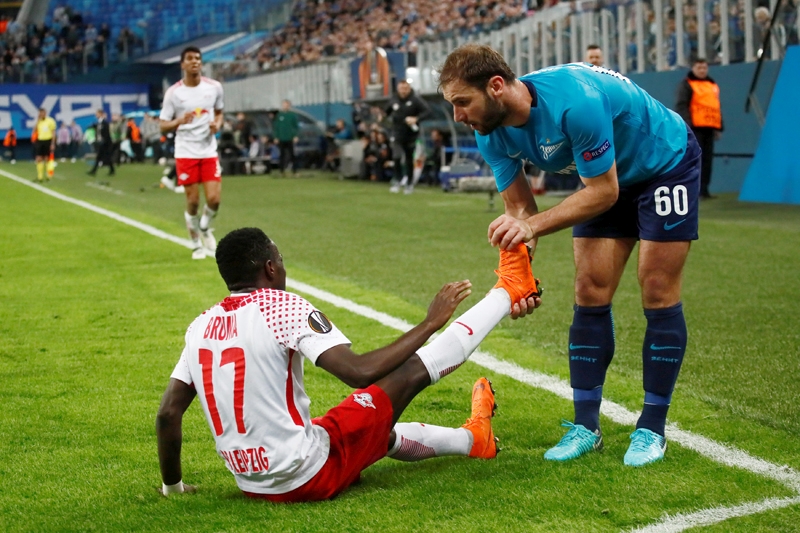You are viewing 1 of your 1 free articles. For unlimited access take a risk-free trial
Shin protection: be on your guard

SPB looks at shin guard use in team sports such as soccer and rugby; how effective are guards at preventing injury and which are likely to provide the most protection?
The most common injuries in team sports such as soccer and rugby are muscle strains and tears, ligament damage and contusions caused by impacts(1). However, although these types of injuries are highly undesirable, fractures are potentially even more serious; a fracture invariably leads to a prolonged layoff and can sometimes even be career threatening. Data from soccer shows that fracture injuries represent between 2-11% of all injuries among players, and that lower extremity fractures account for 30-33% of all fractures sustained(2). Given these risks therefore, the use of shin guards in sports such as soccer, rugby, baseball and hockey to prevent lower leg injury (both fracture and soft tissue) is now routine.Shin guard function
The main function of shin guards is to protect the soft tissues and bones in the lower extremities from external impact. Shin guards provide shock absorption and facilitate energy dissipation, thereby decreasing the risk of a serious injury. In 1994, the International Federation of Association Soccer (FIFA) created FIFA’s Medical Assessment and Research Centre (FMARC) to investigate and to prevent soccer-associated risks to players’ health. FMARC subsequently proposed that shin guard use was a preventive method of reducing injury risk. In a similar vein, shin guard use in rugby has also become popular, especially among forward players(3).However, while a number of studies have concluded that shin guards can significantly reduce the number of minor injuries(4), there’s still some debate in the literature as to whether they can prevent more serious injuries such as tibia fractures(5), especially as soccer tackles causing injuries frequently produce tears or damage to the shin guard. For example, one study investigated impact forces acting on shin guards protecting simulated tibias (wooden rollers) and compared these to non-protected ones(6). It concluded that the shin guards spread the impact forces over a longer period of time, thus reducing the peak impact (most damaging) force. However, the greatest protective effect was observed when maximum forces were below 3,000N. At higher forces – the force that can typically fracture a tibia - protection was far less efficient. The authors concluded therefore that shin guard use was most likely to be useful for protecting against soft tissue injuries rather than fractures.
A later study used female dummies to evaluate the effectiveness of shin guards in attenuating the forces which can lead to lower extremity injuries(7). A pendulum impact apparatus simulated one player being kicked by another, with impacts delivered to the anterior tibial region of the dummy. The researchers found with the shin guards in place, that the load forces were reduced by between 41 and 77% - a very significant reduction. Despite their results however, they were not able to conclude with certainty that shin guard use could significantly reduce the risk of tibia fracture.
Shin guard design
Although the evidence regarding the ability of shin guards to prevent fracture is somewhat limited, there’s still a very good rationale for their use. However, all shin guards are not created equal, which begs the question ‘just what is a good shin guard design’?This isn’t an easy question to answer; firstly, players come in all shapes and sizes, so a design that provides a good anatomical fit and feels comfortable on one person may not be suited to another. Then of course, it’s impossible to amass data on injury protection under controlled laboratory conditions because it’s unethical to ask an athlete to sit in a lab wearing a shin guard while subjecting his/her shin to blows in order to see the type and severity of the injuries sustained!
Despite these difficulties however, a number of studies using shin guards and shin models have been carried out, giving rise to some generalized recommendations. In the simplest terms, use of an appropriate shin guard material, together with the correct geometry are known to be important aspects of shin guard design(8) To achieve this, the use of rigid materials (plastic, carbon, Kevlar, etc) are universally used to form the outer shell in modern shin guards, while soft materials are preferred for the lining of the guard. The following have also been established as desirable criteria:
- A well-designed shin guard should provide adequate protection for the shank, but allow sufficient range of motion of the ankle and the knee(9).
- To increase energy absorption, the shin guard shell should be thick and rigid but an increase in shin guard length (ie greater area to dissipate the impact forces) does not (surprisingly) provide better shock absorption(10-11).
- Fitting the shin guard to the tibial geometry by adding soft material (eg foam) or air bubbles can reduce the peak impact force(10). Some researchers have even suggested filling such gaps with semi-rigid materials(11).
Is carbon the way forward?
The European standards criteria were formulated to minimize the risk of harm to a player’s lower leg that could be caused by another player’s cleats or studs. However, high-energy impacts and the related consequences were not taken into consideration, and this has led some researchers to ask whether the current designs could be improved to increase protection, particularly against fracture. In a 2014 study, researchers attempted to answer exactly this question by testing three leading branded shin guards as well as two custom designs constructed out of carbon fiber(12).In this study, two Adidas shin guards (Addidas Predator and Adidas UCL) were tested alongside one from Nike (Nike Mercurial) as well as two custom-made carbon fiber shin guards (see table 1 for a summary of the shin guards’ construction). A special device with pendulum motion was designed, which was capable of generating large impact forces. The impact mechanism used in this experimental set up was designed to hit the shin guard by the heel of the foot (an area of approximately 20cm2) – see figure 1. The impact values transmitted to artificial tibias were recorded for a wide range of forces, from low to very high. Crucially, the forces were recorded from a large number of sensors under the shin guards, which provided a realistic reflection of the injury risk during real impacts during a game.
Table 1. The structural characteristics of the materials used(12)

Figure 1: The testing apparatus used to determine force transmission through different shin guards(12)

Results
*Low Impact Force (LIF) - In the LIF trials, 2.8-9.6 % of the load was transmitted through the shin guards to the sensors on the artificial tibia. Of the five shin guards tested, the maximum transmitted force was significantly lower when the two carbon fiber guards were worn (ie these offered more protection) and each of these carbon guards was equally as effective as the other. Of the three commercial models tested, the Nike Mercurial shin guard provided better protection than either the Adidas Predator or the Adidas UCL, which performed similarly.*High Impact Force (HIF) - In the HIF trials 5.2-10.9% of the load was transmitted to the sensors on the artificial tibia. Once again, the maximum force and the impulse were significantly lower for the carbon shin guards than for the three polypropylene models – typically around 40-50% less load transmitted. This time however, there were no significant differences in the maximum force transmitted through the Adidas Predator, Adidas UCL and the Nike Mercurial guards although the researchers noticed that wearing the Adidas Predator guard resulted in a longer impulse time over which the force acted. Importantly, the highest recorded impact force in any of the tests was just 262N – much, much lower than the nearly 3000N force required to produce fracture.
From their findings, the researchers were able to draw a number of conclusions about shin guard design:
- The fact that the carbon models proved to be superior was attributable to the inherently rigid nature of carbon fiber (which deforms less) as well as to their custom-made design, which hugged the shin more efficiently, spreading out the load.
- Polypropylene shin guards bend more due to their plastic construction, which means greater forces acting on the tibia/soft tissue for longer.
- Both the shell and the ridge of the lining of the Nike Mercurial model were thicker than those of the Adidas UCL, which resulted in a superior performance during the LIF trials.
- The load transmitted onto the front of the tibia at all levels of impact was significantly below the predicted load level required to fracture the tibia. Although the force generated in a soccer tackle or other boot-to-shin impact can exceed those used in this study, the evidence suggests that all the tested shin guards were able to provide a fair degree of protection.
Implications for team sport players
There’s strong evidence that a tibia protected by a shin guard is unlikely to sustain a fracture providing of course that the shin guard comes between the player’s shin and the opponent’s boot! Given the catastrophic effects of a tibial (shin) fracture, using a shin guard for high-impact team sports where the lower limbs are exposed seems like a no brainer. Having said that, the forces transmitted through a shin guard are still sufficient to result in soft tissue injury and in this respect, carbon shin guards appear to provide superior protection, especially when combined with an EVA lining. Regardless of the shell or lining material, any shin guards used should conform to the relevant European/US standards described in above, and be sized correctly to ensure a good fit that both hugs the shin and feels comfortable in use.References
- British Journal of Sports Medicine 1999; 33, 196-203
- British Journal of Sports Medicine 1996; 30, 171-175
- Med Sci Sports Exerc. 2001 Dec;33(12):2131-8
- American Journal of Sports Medicine 1982 10, 75-78
- Clinics in Sports Medicine 1998; 17, 769-777
- Z Orthop Ihre Grenzgeb. 1985 Nov-Dec;123(6):951-6
- Clin J Sport Med. 1995;5(2):95-9
- “The biomechanics of soccer surfaces and equipment”. In: Science and Soccer. 1st edition (1996). Ed: Reilly, T. Taylor & Francis Group. 135-150
- “The prevention of injuries in youth soccer”. Michigan Governor’s Council on physical fitness, health and sports files.leagueathletics.com/Images/Club/6097/The%20Prevention%20of%20injuries.pdf
- American of Journal Sports Medicine 2000; 28, 227-233
- Sports Engineering 2003; 6, 207-220
- Journal of Sports Science and Medicine (2014) 13, 120-127
Related Files
Newsletter Sign Up
Testimonials
Dr. Alexandra Fandetti-Robin, Back & Body Chiropractic
Elspeth Cowell MSCh DpodM SRCh HCPC reg
William Hunter, Nuffield Health
Newsletter Sign Up
Coaches Testimonials
Dr. Alexandra Fandetti-Robin, Back & Body Chiropractic
Elspeth Cowell MSCh DpodM SRCh HCPC reg
William Hunter, Nuffield Health
Keep up with latest sports science research and apply it to maximize performance
Today you have the chance to join a group of athletes, and sports coaches/trainers who all have something special in common...
They use the latest research to improve performance for themselves and their clients - both athletes and sports teams - with help from global specialists in the fields of sports science, sports medicine and sports psychology.
They do this by reading Sports Performance Bulletin, an easy-to-digest but serious-minded journal dedicated to high performance sports. SPB offers a wealth of information and insight into the latest research, in an easily-accessible and understood format, along with a wealth of practical recommendations.
*includes 3 coaching manuals
Get Inspired
All the latest techniques and approaches
Sports Performance Bulletin helps dedicated endurance athletes improve their performance. Sense-checking the latest sports science research, and sourcing evidence and case studies to support findings, Sports Performance Bulletin turns proven insights into easily digestible practical advice. Supporting athletes, coaches and professionals who wish to ensure their guidance and programmes are kept right up to date and based on credible science.











